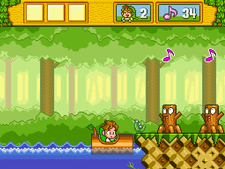DoReMi Fantasy
| DoReMi Fantasy: Milon's DokiDoki Adventure | |
|---|---|
 | |
| Developer(s) | Hudson Soft |
| Publisher(s) | Hudson Soft |
| Director(s) | Yukiko Mikami |
| Producer(s) |
Shigeki Fujiwara Takeshi Sawaguchi |
| Designer(s) |
Tadayuki Kawada Koji Innami |
| Programmer(s) |
Yasuhiro Kosaka Atsuo Nagata Tetsuharu Takashima |
| Composer(s) | Jun Chikuma |
| Platform(s) | Super Famicom |
| Release date(s) |
|
| Genre(s) | Platformer |
| Mode(s) | Single-player |
DoReMi Fantasy: Milon's DokiDoki Adventure (ドレミファンタジー ミロンのドキドキ大冒険 "DoReMi Fantasy: Milon no DokiDoki Daibouken") is a 1996 game released only in Japan for the Super Famicom by Hudson Soft. The game is a sequel to the 1988 NES game, Milon's Secret Castle.
It was re-released for the Wii's Virtual Console in North America on March 10, 2008, under the "Import" category, and in Europe as part of the 3rd Hanabi Festival on September 5, 2008. This version is virtually identical to the original version, and was not translated.[1]
Story
In the game, Milon, a young boy, heads in a mission to restore the music from the forest of his hometown and rescue his friend, the fairy Alis, from an evil wizard known as Amon, who is also responsible for the music's disappearance. To do this, he must collect a series of magic instruments that are being held by Amon's strongest minions. However, said instruments have had their power locked away after Amon corrupted them, so Milon must also collect stars to purify the instruments.
Gameplay

DoReMi Fantasy is somewhat different from the original Milon's Secret Castle. This game is more of a straight platformer, while its predecessor combined platforming with puzzles and exploration. The game also has a more lighthearted and whimsical tone than the original.
- The game no longer takes place at a dark castle with several rooms, but in several thematic areas spread in 7 worlds, which are displayed in a world map. Each world is divided by a few levels that must be cleared one after another, with a boss at the end.
- Milon's basic attack still consists of bubbles, although they are now used to trap enemies in them first and pop them, before the enemies escape. There are other, more powerful attack techniques such as a charged bubble, and various power-ups are able to enhance Milon's bubble-blowing, such as ones that increase his range or the number of bubbles he can blow in one interval. Bubbles can still be used to destroy blocks to uncover items or open new paths in the levels.
- Powerups allow Milon to accomplish special moves, such as the bubblegum, allowing Milon to momentarily float when he falls in the hole.
- Milon can jump on enemies, but they will only be stunned.
- Milon's health level is reflected by the clothes he is wearing. If he hasn't been touched, his clothes are colored green. When he is hit, his clothes will changed to blue, and later, red. If he is touched while wearing red, the player loses a life. The player is able to restore health by picking up overalls power-ups; one pair of overalls restores one unit of health, while twin overalls restore two. Unlike the first game, dying once does not mean game over, as the player can collect extra lives throughout the level.
- Milon can collect a variety of items to aid him throughout the level. These include winged boots that allow him to slow his descent by holding the B button in midair, bubblegum that will save him from a fall down a bottomless pit (but is consumed after it is used), and keys that are required to clear maze stages.
References
- ↑ "DoReMi Fantasy and Puyo Puyo 2 Now Available on Wii Shop Channel!". Nintendo of America. 10 March 2008. Retrieved 9 September 2009.